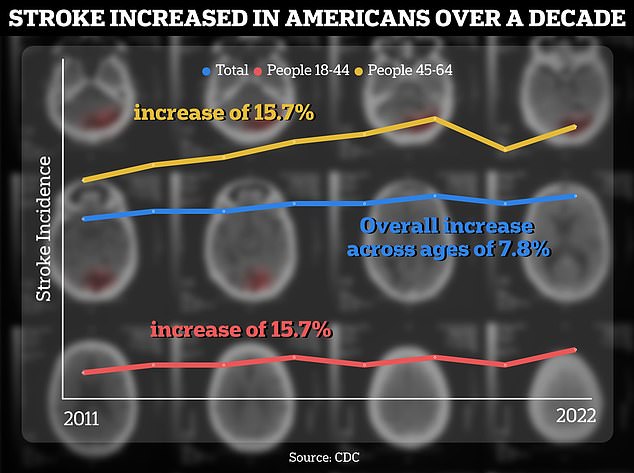Stroke rates under 45 have risen 15% in a decade, new CDC data shows… amid a young cancer spike
According to a new report from the CDC, stroke rates in people under the age of 45 have increased by nearly 15 percent since 2011.
The increase is nearly twice that of Americans of all ages, at 7.8 percent, making strokes the fifth leading cause of death in America.
The agency is seeing a simultaneous national increase in the number of people suffering from known risk factors for the deadly condition, such as obesity, high blood pressure and drug addiction.
The findings come amid the alarming rise in cancer rates among young Americans, which is baffling doctors.
Research shows that the number of cases of the disease among people under 50 has risen by a third in the past twenty years.
Strokes are a disease caused when blood flow to the brain is interrupted, causing swelling and death of brain tissue. If left untreated, it can lead to death and severe disability.

Comparing stroke cases between 2011 and 2013 with stroke cases between 2020 and 2022, the CDC report found that the number of strokes in people aged 18 to 64 increased by about 15 percent.
This is not the first report to find an increase in stroke in young people. A 2023 report of the American Heart Association (AHA) found that the rate of stroke in people under the age of 49 has risen steadily over the past thirty years.
The AHA could not pinpoint a single cause for this phenomenon, but said it is likely due to the fact that young people have been subject to increased stress, more sedentary lifestyles and more drug use than previous generations.
Conditions that contribute to stroke, such as obesity, high cholesterol and diabetes, are more common in younger people today than in the past, the report said.
‘The good news is that these are modifiable risk factors. No one is destined to have a stroke,” said Dr. Christopher David Anderson, a neurologist at Mass General Brigham, in response to the AHA study.
He added: ‘Treating your other risk factors and taking charge of your health is an effective strategy, and it can prevent your risk of stroke from increasing.’
The CDC is working to address this issue as the condition increases – which currently costs taxpayers an estimated $56.2 billion annually.
Conditions such as obesity and blood pressure can increase your risk of stroke because they affect the way blood moves through your body.
A stroke occurs when blood flow to your brain stops, either due to a blood clot or a burst blood vessel.
If blood flow to the brain is lost, brain cells can begin to die.
If the brain is deprived of oxygen-rich blood for too long, you can lose huge parts of this vital organ, which can lead to death.
You can survive a stroke and live with damaged brain tissue if doctors treat you early enough. But if you survive, you can have problems with a whole range of bodily functions: from eating, walking, talking to thinking.
This debilitating disease affected more than 795,000 Americans in 2021. That amounts to about one stroke every 40 seconds.
So it’s no surprise that the CDC is tasked with monitoring this deadly disease.
The CDC reached their conclusions using data from their Annual Behavioral Risk Factor Surveillance System (BRFSS). The BRFSS surveys Americans annually about a range of health conditions and everyday habits, including stroke.
Comparing the 1,419,351 people surveyed from 2011-2013 to the 1,220,972 people surveyed from 2020-2022, they found that 7.8 percent more people had a stroke.
In people aged 18 to 44, there were 14.7 percent more strokes than at the beginning of 2010 in a two-year period. In people aged 45 to 64, there were also 15.7 percent more cases of stroke.
This is a particularly disheartening trend because the number of strokes actually decreased between 2006 and 2010, by about 2.6 percent.
The report also found that people who had not completed high school had the largest increase in stroke rates, an increase of 18.2 percent.
In addition, Black people, Native Americans and non-Hispanic Native Hawaiian or Pacific Islanders were more likely to have a stroke than white people, the report found.
“The health problems that lead to strokes, and the strokes themselves, are more common in traditionally underserved populations. We see even higher rates in populations of African descent, Hispanic descent and East Asian populations,” Dr. Anderson said.
The agency attributed these disparities to the fact that minorities and people with less education tend to have lower incomes and poorer access to hospitals than white people with higher education.
In response to these findings, the agency underscored a renewed national focus on public health programs to increase stroke awareness.
Stroke education is one of the most important ways to interrupt some of the more debilitating parts of the disease, according to the CDC.
That’s because if you suffer a stroke prematurely, there are a variety of treatment options that doctors can provide to save your life and prevent you from becoming seriously disabled.
“Promoting targeted, evidence-based practices and programs for stroke awareness, prevention, and treatment is essential to improving the nation’s cerebrovascular health,” the new CDC report said.
This is evident from the fact that while the number of strokes has increased, the number of Americans dying from them has decreased, according to Dr. Ananth’s 2023 study.
